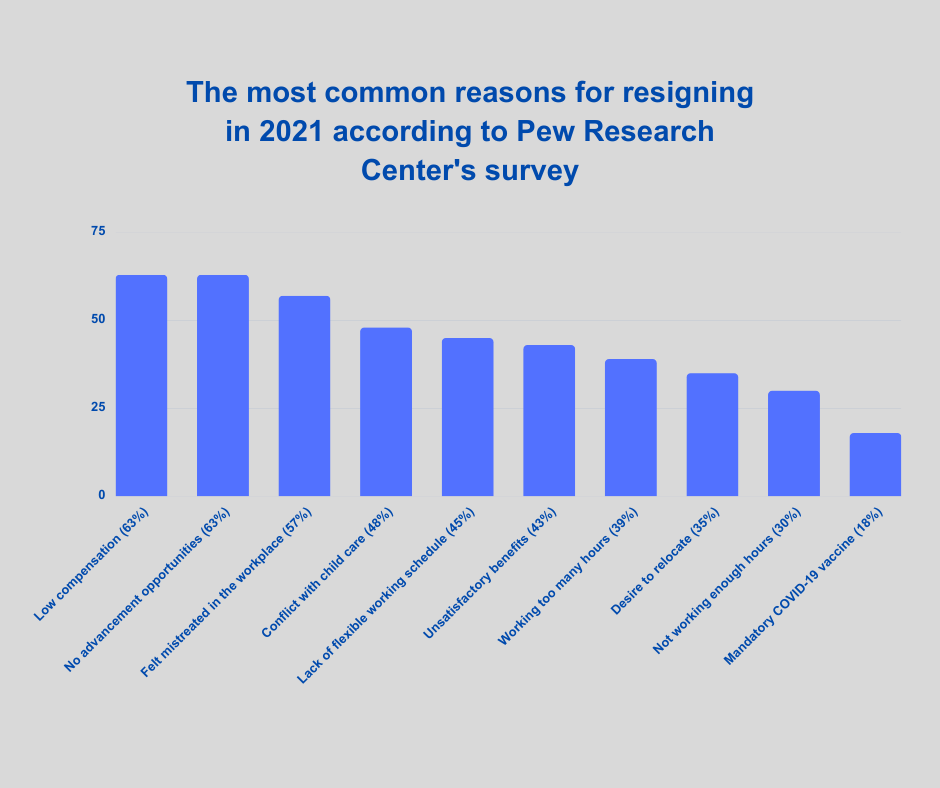
The Recruitment Process: A Step By Step Manual
Unlock the secrets to a seamless and successful hiring process, empowering your organization to build a dynamic and thriving team.


Co-founder of Milkwhale

Head of People at Goosechase
In today’s rapidly evolving world, various shifts changed the employment landscape as we know it. The pandemic spiked the “Great Resignation,” creating a massive job turnover that doesn’t spare an industry. But that was only an introduction to the “Quiet Quitting” trend that followed, rooted in employees’ need to reimagine the workplace.
Add the gig economy and remote work options to this, and you got a brand new, non-traditional employment model that is rapidly changing the professional landscape as we know it.
So, one question hinders: why are so many people quitting their jobs? Why do workers with different backgrounds and job positions decide to leave their current roles?
According to BLS data, despite the growing recession and inflation, over four million people left their job last year each month. Thus, the COVID-19-sparked Great Resignation isn’t coming to a halt.
“The Great Resignation or The Big Quit is an economic trend we are all witnessing today,” said Ebnu Sudarso, Co-founder of Milkwhale. “There are a lot of causes for these mass amounts of resignations.”
From unsatisfactory pay to working too much or too little, better opportunities, or the need for flexibility and growth, workers leave their jobs because they are no longer willing to stay in a position that doesn’t fit them.
Even though this trend is more common among the younger generations, people of all ages are becoming a part of it. In fact, Lever’s report found that 40% of employees of all ages, with the highest attrition rates of 65% among Gen-Zs, are planning to resign within a year.
Despite so many people switching jobs, 50% of HR professionals couldn’t meet their hiring goals in 2021, according to GoodTime’s Hiring Insights Report.
Therefore, understanding why so many people are quitting their jobs in today’s labor shortage could be crucial in recruitment.
As we navigate the core reasons behind these trends along with expert opinions, we will uncover the most common reasons for people handing in their resignations and the challenges faced by employers, and we’ll also take a look at future employment trends and projections in the increasingly competitive labor market.
So, why is everyone quitting their jobs? While uninspiring and low-income jobs seem like valid answers, there are so many reasons for workers quitting in the last few years.
Among the most common reasons why people quit, there are some new factors that newer generations, such as the Millenials and Gen Z, consider detrimental when deciding on leaving a current or accepting a new job position.
These include a desire for work-life balance, CSR initiatives in the workplace, and a pursuit of meaningful work.
Thus, these new demands for purposeful work conditions showed the need for further research and analyses to determine why people quit their jobs and search for appropriate solutions.
Pew Research Center organized and carried out one such survey, with 10,000 panelists answering questions about why they left their jobs.
According to their findings, there were ten main premises for the high number of resignations. Some of the causes were more significant for certain people than for others, but the results show the following reasons:
However, each of these reasons for quitting a job varies depending on different factors, such as:
Educational differences: Employees without a four-year college degree were likelier to cite reasons such as lack of flexibility (49% vs. 34% for college graduates) and fewer work hours (21% vs. 8%).
On the other hand, college graduates were more likely to report higher earnings (66% vs. 51%) and more advancement opportunities (63% vs. 49%). Moreover, those with postgraduate degrees were least likely to have quit their jobs in 2021 (13%).
Demographic differences: Non-White adults were more likely than White adults to cite reasons like not having enough flexibility (52% vs. 38%) and wanting to relocate (41% vs. 30%) as reasons for quitting.
Furthermore, younger adults (below 30) were more likely to have voluntarily left their jobs (37%) than older age groups.
Income differences: Workers with lower incomes were more likely to have quit their jobs in 2021 (24%) compared to middle-income (18%) and upper-income (11%) employees.

McKinsey also surveyed 13,500 responders in their 2022 Great Attrition, Great Attraction 2.0 global survey on why they left their previous employers. Their discoveries identified 12 major incentives for quitting:
Of those responders, 65% didn’t return to the same industry, 48% moved to a completely different sector, 35% took a new job but stayed in the same industry, and 17% decided not to return to the workforce.
Yet the answer to the question of why are so many people quitting their jobs can be roughly summed up in three global trends:
The Great Reshuffle – led by workers switching industries.
The Great Reinvention – or the hybrid and remote work model, as well as gig and part-time jobs that entirely changed traditional employment.
The Great Reassessment – consisted of people that left the workforce and diminished the talent pool in the already tight labor market.
Beyond the obvious reasons for leaving a job, this workforce transformation pinpoints a rather unusual cause, or better put, a need for improved well-being at work.
When the importance of employee mental health, work-life balance, and a supportive work environment are overlooked, that can contribute to additional motives for workers quitting jobs.
As is evident from the surveys mentioned above, the principal reason why employees decide to resign is that they see no possibility of climbing up the career ladder.
Now more than ever, people don’t want to stay in the same role for their entire careers. They are open to opportunities to gain new experiences and willing to try their hand at different positions. They are eager to gain new skills needed for new roles and are fearless in steering in different directions on the career path.
Money has always been a great driver of high churn levels, especially in today’s economy. Inflation is reaching an all-time high, increasing the consumer price index by 9.1% in June 2022, the largest increase in 40 years.
Hence, workers are no longer willing to try and make ends meet by staying in their current roles and having a second job or a side hustle. If they aren’t happy with their earnings, they quietly quit their current positions and look for better-paid jobs with better benefits.
In fact, according to the Pew Research Center’s report, 24% of adults who quit had low income, compared to 18% with middle income and 114% with high salaries.
The report also shows that more than half of those who decided to leave their employer and found a job elsewhere earn more and have access to flexible benefits.
“First, there was the COVID-19 Pandemic,” Ebnu Sudarso commented. “When most offices allowed employees to work from home, there were some companies that did not give their employees the same privilege.”
Nowadays, employees don’t regard flexibility and remote working as a privilege.
In fact, they believe that it should be the norm. If their company doesn’t offer flexible and remote working schedules, employees look for them in other organizations.
In both of the previously mentioned surveys, lack of flexibility is among the top reasons people resigned. The aspiration to design one’s working schedule and WFH is also confirmed by CareerBuilding’s findings, which show that flexible vacancies receive seven times more applicants than in-person ones.
Natasha Delisle-Barrow, Head of People at Goosechase, said, “Employee experience is based on a number of factors; however, the one with the biggest impact on employee retention is leadership.

Humu’s State of the Manager report supports this claim.
According to their findings, workers are 7.9 times more likely to stay at their job if they have a manager who takes action and provides personalized development opportunities.
As Natasha Delisle-Barrow puts it, “We all know the saying “people leave managers, not companies” and it’s truer now more than ever.”
The conversations about why so many people quit their jobs almost always revolve around the reasons for stepping down. But what do the quitters do after they hand in their resignations?
Many people look for jobs with different employers in different industries. In fact, 65% of quitters opted to work in a different industry than they did before.
Consumer/retail, public and social sector, finance, and insurance are the industries that suffered the most significant job losses: 65% to 75% of employees who left did not return to the respective sectors.
However, it’s not only that they don’t want to work in the same sectors – people aren’t interested in traditional full-time jobs anymore. Instead, many take on untraditional roles such as part-time positions, freelancing, or becoming gig workers.
Many are also choosing to become their own boss.
In an April press release, the White House reported that in 2021, new business applications grew by more than 30%, with 5.4 million people wanting to start their own businesses.
This mobility between industries and traditional vs. non-traditional employment has made way for two significant employment trends.
First, with many people cruising among different industries, employers are now eliminating degrees from their hiring criteria and focusing on skills. Hence, college graduates need learning opportunities such as internships and apprenticeships to help them gain experience to be able to compete in today’s tight labor market.
Secondly, the desire for flexibility has pushed ahead the gig economy and hindered traditional work. This has also changed the recruiting process, emphasizing the necessity to meet job seekers’ needs rather than aligning them with company interests.
Despite the sharp increase in job vacancies, employment projections have a favorable view of the future of employment.
According to BLS’s projections, the U.S. economy will experience an increase of 8.3 million jobs from 2021 to 2031. The total number of employees will rise from 158.1 million to 166.5 million. However, the annual growth percentage of 0.5 will be slower than the 1.0% yearly growth recorded between 2011 to 2021.
The Australian government also projects that employment will rise over the following years. Their data shows four industries will absorb more than three-fifths of the total growth: health care and social assistance, accommodation and food services, professional, scientific, and technical services, and education and training.
The employment growth in Europe between 2020 to 2030, particularly for jobs in Europe, is estimated at 5. However, within the EU, some countries are projected to experience an increase, but others’ employment rates will drop, based on Cedefop’s projections.
Considering the sectors, most people will steer clear of agriculture, forestry, fishing, mining, and quarrying. In contrast, accommodation, food, and the health and social care sector will attract more new workers.

The last few years have utterly changed the workforce as we know it. Hence, now is the time for companies to ask why are so many people quitting their jobs and use insights to make meaningful changes in their efforts to recruit, attract, and retain talent.
Even though this shift is challenging, especially for employers, it also serves as a catalyst for change, resulting in a modern workforce ready to adapt, innovate, and support employees and organizations.
Browse our curated list of vendors to find the best solution for your needs.
Subscribe to our newsletter for the latest trends, expert tips, and workplace insights!

Unlock the secrets to a seamless and successful hiring process, empowering your organization to build a dynamic and thriving team.

Is rage applying just another short-lived TikTok trend or a promising employee strategy for landing a better job?

Unlock the secrets to crafting an ATS-friendly resume that stands out in the job market with valuable insights and tips to navigate applicant tracking systems effectively.

What happens when one recruiter owns the entire hiring journey? Full-cycle recruiting transforms the fragmented steps, from preparation to onboarding, into a connected journey that builds trust and results.
Used by most of the top employee benefits consultants in the US, Shortlister is where you can find, research and select HR and benefits vendors for your clients.
Shortlister helps you reach your ideal prospects. Claim your free account to control your message and receive employer, consultant and health plan leads.